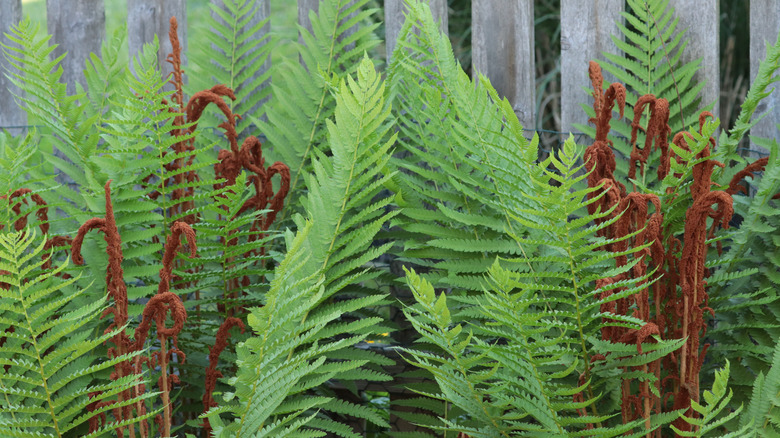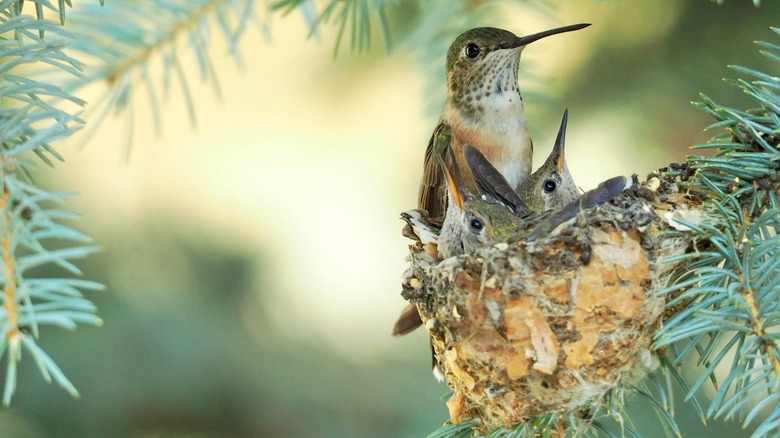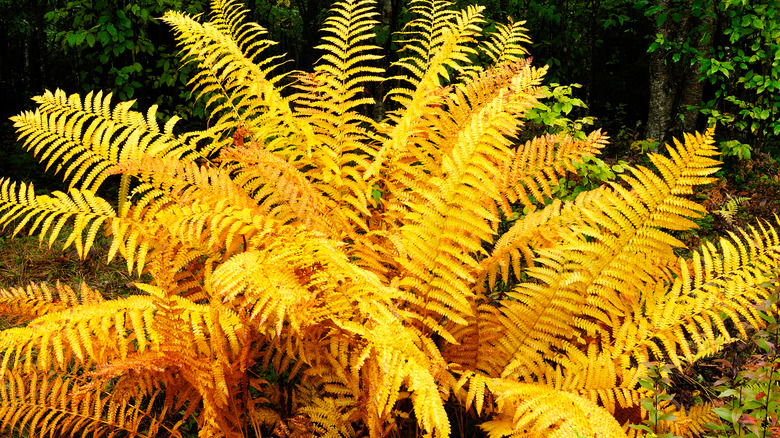Why Hummingbird Lovers Will Want To Add Cinnamon Fern To Their Garden
Flowers are like highway billboards for hummingbird gardens. Their flashy, attention-grabbing colors tempt teeny travelers to stop over and have a quick meal. But whether these visitors decide to stick around for the summer depends on the other amenities available. Having a variety of nectar-rich flowers is important for attracting hummingbirds to your garden, but hummers also need plants like cinnamon fern that produce the woolly fibers they require for nesting materials. Adding a few of these fleecy ferns can transform your garden from a hummingbird pit stop to a summer vacation home.
Cinnamon ferns (Osmundastrum cinnamomeum) are perennial plants native to much of the eastern and central United States. They can grow up to 6 feet tall and sport large, brilliant green, lance-like leaves that turn yellow in the fall. In early spring, these ferns produce spore-bearing fertile fronds, which quickly transform from green to cinnamon-brown. Soon after the fertile fronds appear, the ferns sprout sterile, yellowish-green fiddlehead fronds that become the leaves. When these fiddleheads emerge, they are initially covered in dense, silver-white wool or fuzz that eventually turns brown and falls off — although some wool remains on the underside of the leaves. Hummingbirds use these fuzzy fibers to construct their nests.
How cinnamon fern helps hummingbirds
Female hummingbirds spend several hours a day for roughly a week building plush, cup-like nests. They start by weaving together spider webs with bits of plant matter. In addition to holding the nest together, these sticky strands provide elasticity and allow the nest to expand as the baby birds grow. When construction is complete, the birds line the inside of the nests with soft, downy materials, like the fuzzy fibers from cinnamon fern fronds. This soft lining provides a cushy bed, but even more importantly, the fuzzy fibers provide insulation that keeps the eggs and nestlings warm.
Native plants like cinnamon fern are valuable additions to hummingbird gardens. Because hummingbirds grew up with these native plants, they are accustomed to seeking them out and often prefer them over non-native species. Plus, native plants are better adapted to local soils, environmental conditions, and growing seasons, which makes them more likely to survive. Cinnamon ferns are especially important to ruby-throated hummingbirds. These birds are the only species of hummingbird that breeds in the eastern U.S., and cinnamon ferns are found throughout their natural breeding range. Because they are familiar with these plants in the wild, it's likely that planting cinnamon ferns will keep hummingbirds coming back to your yard.
How to grow cinnamon ferns
Fortunately, cinnamon ferns are easy to grow. They do best in medium to wet acidic soils that are well-drained and rich in humus. While these ferns prefer full to partial shade, they can tolerate sun if the soil is kept constantly moist. They can be grown in containers but will require more frequent watering. A rich potting mix with added compost helps retain moisture. Cinnamon ferns aren't susceptible to many pests or diseases, and they are deer resistant.
If you want to attract ruby-throated hummingbirds, you should plant these ferns in early- to mid-spring. Space them 2 feet apart and plant them deep enough so the root crown is just above soil level. Like many ferns, these plants spread by rhizomes and tend to form clumps. Cinnamon ferns are compatible with many plants, but in the wild, they are often found alongside other hummingbird-friendly species like marsh marigold (Caltha palustris), swamp pink (Helonias bullata), and great blue lobelia (Lobelia siphilitica). To find other compatible flowers that hummingbirds love, search the native plant databases from Audubon or the Lady Bird Johnson Wildflower Center. If your hummingbird garden is filled with flashy flowers but lacks other amenities, look for ways to incorporate plants that provide soft nesting materials. Cinnamon ferns work great as a backdrop for flowering plants or as filler underneath trees. However you decide to use them, these fuzzy ferns can transform your garden from a simple stopover to a full-service hummingbird haven.


